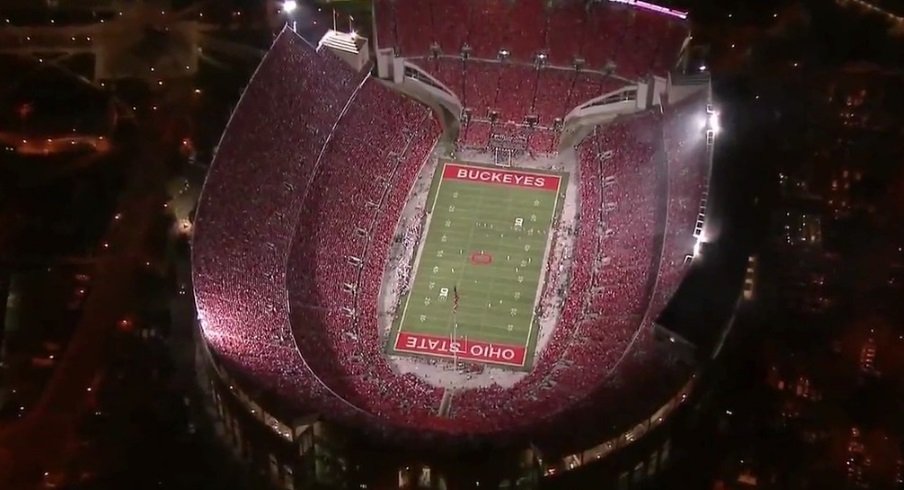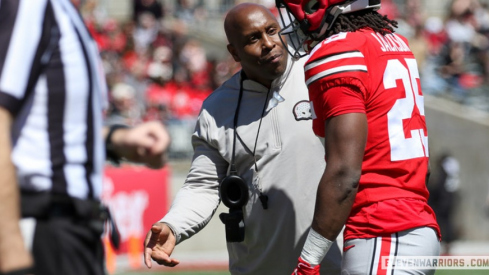College football is in trouble.
So sayeth professional take-haver Danny Kanell! And he's correct, but it's the kind of ass-backwards correct that people stumble into accidentally after losing their glasses in the dark, Velma-style.
I'll get to that in a second, but a quick note about Danny Kanell: for every occasional rational, well thought-out opinion that he whispers into the ether, he has about fifty nonsensical thoughts that probably never should've been expressed in public.
Like, yeah; the SEC should be ripped when it has largely bad offenses that are boring and dumb, which is a lot of the time. But what's this? The health issues of concussions in football are a conspiracy perpetuated by the media? Players don't deserve to be compensated? Ohio State would be happy to win nine games in 2018? UCLA is a dormant College Football Playoff powerhouse? These are the takes of a man throwing undercooked CBS college football spaghetti at the wall and seeing what sticks, and most of it does not.
But! Though Kanell is very often not a whole lot more than a bad takes factory in a turtleneck, the former Florida State quarterback has at least one extremely redeeming feature as a sports broadcaster, which is that he unabashedly rips on the SEC whenever he gets a chance (he's said he tries "to be the voice for the other conferences," which, uhhhh thanks?).
This is great for two reasons. First, he's employed by CBS, one of the primary broadcasters of SEC games. There is nothing quite as thrilling as watching someone deliberately bite the hand that feeds them. It rules. Secondly, sometimes it leads Kanell into a logical alleyway that doesn't just dump him out into a sewer.
Hate to say it but college football is in trouble. Last years regular season was a snooze fest. Playoff games? Same. Clemson and Bama dominance is problematic.
— Danny Kanell (@dannykanell) July 18, 2019
Solution?
Cut schedule to 11 games Eliminate FCS cupcakes
P5 must play 10 P5
Expand playoffs to 8 teams
Even if Danny's inspiration behind the meat of this tweet (that the college football schedule should be truncated and teams should be forced to play better teams) wasn't animus towards the SEC, well hell, it's my inspiration behind agreeing with him wholeheartedly.
When Kanell says that "college football is in trouble," that's a relative measure. It's still a wildly popular and profitable sport for a lot of colleges. The Big Ten and the SEC are bringing in billions in revenue, mostly through TV contracts built on football. The "trouble" exists on the margins, and in Columbus we tend to only see this when the likes of Florida A&M come to town to take their beating and collect their million bucks or so in front of announced crowds of around 98k and actual crowds of something more like 80k.
That's not ideal, but Ohio State still pulled in over $200 million in revenue in 2018. That was very nearly matched by the expenses involved in the running of several dozen varsity sports, the payment of coaches, and the construction and maintenance of facilities, but Gene Smith probably isn't sweating it.
He's one of the few athletic directors with that luxury.
One of my favorite college sports-related resources over the years has been USA TODAY Sport's analysis of the finances of 230 collegiate athletic departments from the 2016-2017 fiscal year. Though it isn't current (and frankly, the fact that they were able to compile the data at all was a minor miracle), it provides a pretty dire snapshot of the incredible difference between the football haves and have nots in the college world.
Again, Ohio State football and Ohio State sports in general really isn't in any trouble. The athletic department doesn't collect funds from either students or the school to run its operations, and (as of the 2016-17 reporting from USA TODAY), neither do places like Texas, Penn State, LSU, and somehow Purdue, which has a giant train filled with TV contract money that rolls around campus and sometimes belches out $10 bills from its smokestack for delighted students. And also Nebraska and Oklahoma and a few other schools, but the point is that we're talking about maybe a dozen or so out of several hundred that aren't using sports as a cudgel.
Instead, the norm across the country is for collegiate athletic departments to rely on student and university funds to maintain a budget that includes money for all kinds of sports, but particularly football, by far one of the most expensive sports to run and govern.
It's bad for even mid-tier FBS schools. For example, Arizona State charges each student a $75 "athletic fee," which pays for the cost of admission to sporting events but is also, you know, mandatory. Almost 22 million of ASU's nearly 100 million in revenue during 2016-17 was made up from either student fees or contributions from the university itself. Given that athletic department expenses nearly matched revenues, it's not a stretch to say that many ASU sports exist because of the largesse of ASU students (willingly or not).
And at the FCS level, it gets much, much worse.
Let's use Tennessee-Chattanooga as an example. In 2017, the FCS football Mocs went to Death Valley and lost to LSU 45-10, a noble FBS vs FCS asskicking; a blowout, but a gentlemanly blowout. As it turned out, that asskicking was a financial necessity because with ticket sales dipping to their lowest in three seasons and other financial contributions not picking up the slack, Tennessee-Chattanooga's athletic department looked to the student body and the university to make up the difference. Of the close to $18 million in revenue the Mocs collected, nearly 70% of it came from outside of the athletic department.
In short, those cupcake FCS teams collecting millions of dollars to get utterly destroyed during a noon game by a top 10 opponent are making a financial calculation designed to keep their most expensive sports above water, and even then they still need to be extensively bailed out by their schools.
Lot of people worried about FCS schools losing $$. Heres the soloution: schedule FCS in spring and use those as spring game. Give them the gate. Spring games could use some life too.
— Danny Kanell (@dannykanell) July 18, 2019
Over the last 5 years Ive run this by at least a dozen head coaches and all love the idea
No. No!
Sorry Danny, this is a terrible idea for a ton of reasons, such as "With attrition from graduation and the draft, who would even start in these games?" and "Why the hell would a good team put any of its players at risk for injury?" and "Would fans even give a half of a damn just because it's a 'real' team?" and "Players are already sitting out bowl games, if you had any shot at the NFL at all you'd be insane to play an exhibition game in April against Moonshine State" but the one that sticks out for me is "Hey, maybe a lot of these FCS and FBS football programs just straight up shouldn't exist."
That probably sounds a bit callous coming from the likes of an Ohio State fan with an athletic department swimming in gold and rubies, so I'll be blunt and even more mean: if a collegiate athletic department needs to collect either tens of millions of dollars or more than 50% of its operating revenue from students and the university to maintain expensive sports like football, it should not have those sports. Period.
From a 2016 article in the Post and Courier about athletic fees in South Carolina:
“The issues are not with schools like Michigan, or Clemson and South Carolina,” said USC Upstate business professor Jeff Smith, who has studied finances in college athletics. “The issues are with schools like Coastal Carolina and College of Charleston and Winthrop and The Citadel, which depend so much on student athletic fees.”
On September 21st, Ohio State will play the Miami Redhawks, who suck. They suck because they are bad at football, but in another sense they suck because ticket sales have stayed flat or declined for years while student athletic fees have steadily increased, year after year after year.
Having a football team is a point of pride for colleges and universities, but more than ever it's also a selling point to donors and prospective students, who then are forced to subsidize that same team and others. It's a ridiculous situation that wafts over to actually sustainable programs like Ohio State, as we watch the Buckeyes water down its schedule and muddle through 2-3 games a season against bad opposition.
That doesn't benefit anyone, except those who believe that any football is good football. But even if that's true, at some point the price tag is just too damn high.


